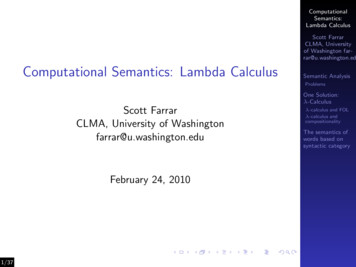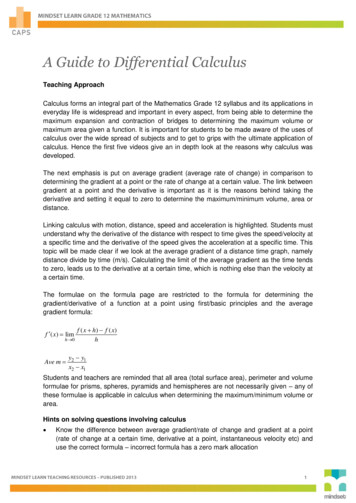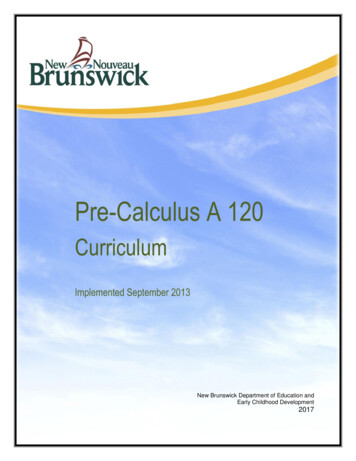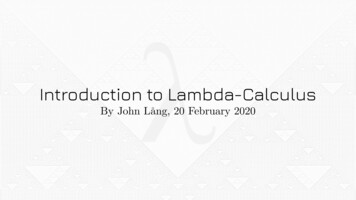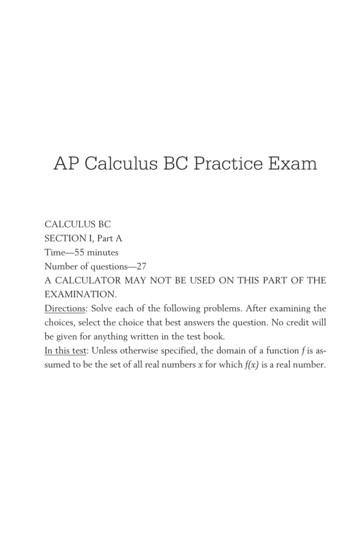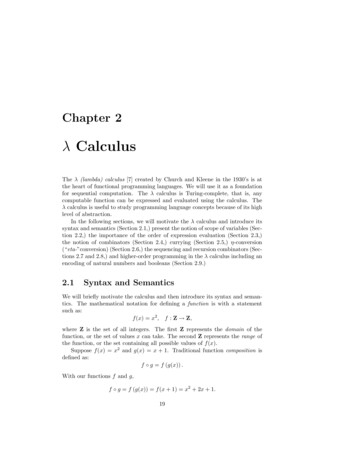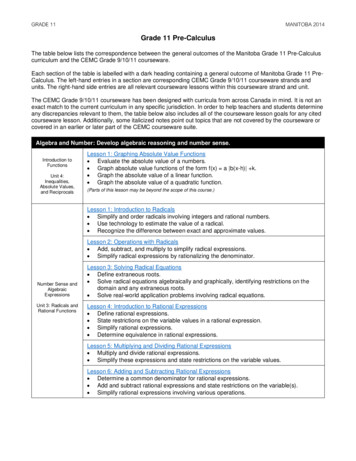
Transcription
GRADE 11MANITOBA 2014Grade 11 Pre-CalculusThe table below lists the correspondence between the general outcomes of the Manitoba Grade 11 Pre-Calculuscurriculum and the CEMC Grade 9/10/11 courseware.Each section of the table is labelled with a dark heading containing a general outcome of Manitoba Grade 11 PreCalculus. The left-hand entries in a section are corresponding CEMC Grade 9/10/11 courseware strands andunits. The right-hand side entries are all relevant courseware lessons within this courseware strand and unit.The CEMC Grade 9/10/11 courseware has been designed with curricula from across Canada in mind. It is not anexact match to the current curriculum in any specific jurisdiction. In order to help teachers and students determineany discrepancies relevant to them, the table below also includes all of the courseware lesson goals for any citedcourseware lesson. Additionally, some italicized notes point out topics that are not covered by the courseware orcovered in an earlier or later part of the CEMC courseware suite.Algebra and Number: Develop algebraic reasoning and number sense.Introduction toFunctionsUnit 4:Inequalities,Absolute Values,and ReciprocalsLesson 1: Graphing Absolute Value Functions Evaluate the absolute value of a numbers. Graph absolute value functions of the form f(x) a b(x-h) k. Graph the absolute value of a linear function. Graph the absolute value of a quadratic function.(Parts of this lesson may be beyond the scope of this course.)Lesson 1: Introduction to Radicals Simplify and order radicals involving integers and rational numbers. Use technology to estimate the value of a radical. Recognize the difference between exact and approximate values.Lesson 2: Operations with Radicals Add, subtract, and multiply to simplify radical expressions. Simplify radical expressions by rationalizing the denominator.Number Sense andAlgebraicExpressionsUnit 3: Radicals andRational FunctionsLesson 3: Solving Radical Equations Define extraneous roots. Solve radical equations algebraically and graphically, identifying restrictions on thedomain and any extraneous roots. Solve real-world application problems involving radical equations.Lesson 4: Introduction to Rational Expressions Define rational expressions. State restrictions on the variable values in a rational expression. Simplify rational expressions. Determine equivalence in rational expressions.Lesson 5: Multiplying and Dividing Rational Expressions Multiply and divide rational expressions. Simplify these expressions and state restrictions on the variable values.Lesson 6: Adding and Subtracting Rational Expressions Determine a common denominator for rational expressions. Add and subtract rational expressions and state restrictions on the variable(s). Simplify rational expressions involving various operations.
GRADE 11MANITOBA 2014Trigonometry: Develop trigonometric reasoning.Lesson 1: Trigonometric Ratios of Angles in Standard Position Draw angles in standard position on the Cartesian plane. Determine the primary trigonometric ratios of angles from 0 to 360 .Measurement,Geometry, andTrigonometryUnit 4:Angles in StandardPosition andTrigonometricIdentitiesLesson 2: Related and Coterminal Angles Define and calculate related acute angles and trigonometric ratios for angles between0 and 360 . Calculate the measure of angles between 0 and 360 from a given trigonometric ratio. Define coterminal angles to connect negative angles and angles greater than 360 with angles between 0 and 360 .Lesson 3: Trigonometric Ratios of Special Angles Recognize connections between the angles and the side lengths of a right isoscelestriangle and between the angles and side lengths of an equilateral triangle. Draw and find points on the terminal arm of angles in standard position with relatedacute angles of 30 , 45 , and 60 . Calculate exact values of the sine, cosine, and tangent ratios for angles related to 30 ,45 , 60 , and 90 . Relate the points on the unit circle to the primary trigonometric ratios of angles instandard position.Lesson 5: The Sine Law State and prove the sine law. Use the sine law to compute one unknown side length or angle in an acute triangle. Use the sine law to determine all side lengths and angles in an acute triangle.Lesson 6: The Cosine Law State and prove the cosine law. Use the cosine law to compute an unknown side length in an acute triangle. Use the cosine law to determine the interior angles of an acute triangle.Measurement,Geometry, andTrigonometryUnit 3:TrigonometryLesson 7: Applications with Acute Triangles Identify when to apply the sine and cosine laws given incomplete information about theside lengths and angles in an acute triangle. Solve a multistep problem that involveso two or more applications of the sine or cosine laws,o interior and exterior angle properties of triangles, oro two or more acute triangles.Lesson 8: Oblique Triangles Compute the sine, cosine, and tangent ratios for obtuse angles. Determine the oblique angle or angles corresponding to a given trigonometric ratio. Solve an oblique triangle using the sine and cosine laws and correctly handle theambiguous case of the sine law when encountered.Lesson 9: Applications in Three-Dimensional Settings Define a set of adjoining triangles to relate unknown lengths and angles to knownlengths and angles in a three-dimensional setting. Determine a specific unknown length of angle in a three-dimensional setting byapplying trigonometric tools to a set of adjoining triangles.(Parts of this lesson may be beyond the scope of this course.)
GRADE 11MANITOBA 2014Relations and Functions: Develop algebraic and graphical reasoning through the study of relations.Quadratic RelationsUnit 3:Algebraic SkillsIntroduction toFunctionsUnit 4:Inequalities,Absolute Values,and ReciprocalsQuadratic RelationsUnit 2:AlgebraicRepresentations ofQuadratic RelationsQuadratic RelationsUnit 3:Algebraic SkillsQuadratic RelationsUnit 5: SolvingProblems InvolvingQuadratic RelationsLesson 2: Factoring – Common and Trinomials Factor an expression using common factoring. Factor a trinomial of the form x2 bx c. Factor a trinomial of the form ax2 bx c with a 1 by decomposition of byinspection.Lesson 3: Factoring – Difference of Squares and Perfect Squares Factor difference of squares. Factor perfect squares. Determine which type of factoring applies to a given expression. Factor expressions requiring more than one type of factoring.Lesson 4: Graphing Absolute Value Functions Evaluate the absolute value of a number. Graph absolute value functions of the form f(x) a b(x-h) k using transformations. Graph the absolute value of a linear function. Graph the absolute value of a quadratic function.Lesson 5: Solving Absolute Value Equations Solve an absolute value equation graphically. Solve an equation involving the absolute value of a linear function algebraically. Solve an equation involving the absolute value of a quadratic function algebraically.Lesson 3: Exploring Vertex Form Determine the vertex of a quadratic relation given the vertex form equation. Determine the vertex form equation of a quadratic relation given the vertex. Convert the factored form equation of a quadratic relation to the vertex form equation.(Parts of this lesson may be beyond the scope of this course.)Lesson 4: Completing the Square Select an appropriate constant to create a trinomial that is a perfect square. Write the equation of a quadratic relation in vertex form by completing the square. Apply the process of completing the square to answer questions involving the vertex,maximum, or minimum of a quadratic relation.Lesson 1: Solving Quadratic Equations Recognize quadratic equations. Solve quadratic equations in various forms by graphing, by applying inverseoperations and by factoring. Check solutions to quadratic equations by graphing or by performing a formal check. Solve application problems that involve solving a quadratic equation.Lesson 2: Introduction to the Quadratic Formula Derive the quadratic formula. Determine the roots of a quadratic equation using the quadratic formula. Determine the zeros of a quadratic relation using the quadratic formula. Apply the quadratic formula in a variety of contexts.
GRADE 11MANITOBA 2014Lesson 4: Intersections of Linear and Quadratic Relations Identify the possible number of points of intersection between a linear relation and aquadratic relation. Identify the point(s) of intersection between a linear relation and a quadratic relationboth graphically and algebraically. Use the discriminant to determine the number of point(s) of intersection between alinear relation and a quadratic relation.Lesson 5: Applications Use partial factoring to determine the vertex of a quadratic relation. Solve problems involving substitution into a quadratic relation. Solve problems that require solving a quadratic equation. Solve problems that involve finding the maximum or minimum of a quadratic relation. Select an appropriate computational strategy depending on the problem.Solving quadratic-quadratic systems is not covered by the courseware.Introduction toFunctionsUnit 1:RepresentingFunctionsIntroduction toFunctionsUnit 4:RepresentingFunctionsSequences, Series,and FinancialLiteracyUnit 1: RepresentingSequencesSequences, Series,and FinancialLiteracyUnit 2: Arithmeticand GeometricSequences andSeries and FinancialApplicationsLesson 3: Domain and Range Determine the domain and range of a function containing only a few points. Use set notation to describe the domain and range of a given function. Determine the domain and range of quadratic functions.Lesson 1: Solving Single-Variable Inequalities Express a set of real numbers using interval notation. Solve linear inequalities, including compound or simultaneous inequalities, usinginverse operations. Use different strategies to solve quadratic inequalities, such as graphing, caseanalysis, or sign analysis. Solve applications involving linear and quadratic inequalities.Lesson 2: Inequalities in Two Variables Determine if an ordered pair is a solution to a two-variable inequality. Sketch the graph of a linear or quadratic inequality in two variables. Solve application problems that involve a linear or quadratic inequality in twovariables.Lesson 1: Introducing Sequences Express sequences numerically and graphically, using term notation. Represent sequences algebraically, using a recursion formula. Represent sequences algebraically, using a general term or function notation. Make connections between the different algebraic representations of sequences.Lesson 1: Arithmetic Sequences Identify if a sequence is arithmetic. Determine a recursive formula for an arithmetic sequence. Determine the general term of an arithmetic sequence. Solve questions about arithmetic sequences using the general term.Lesson 5: Arithmetic Series Define a series as the sum of the terms of a sequence. Derive two formulas for the sum of the first n terms of an arithmetic series. Solve problems using the formulas for the sum of the first n terms of an arithmeticseries.Lesson 3: Geometric Sequences Identify a geometric sequence. Determine a recursion formula for a geometric sequence. Determine and apply the formula for the general term of a geometric sequence. Solve problems involving geometric sequences.
GRADE 11MANITOBA 2014Lesson 6: Geometric Series Define a geometric series. Derive a formula for the sum of the first n terms in a geometric series (S n) and use thisformula to calculate sums of given geometric series. Solve problems involving the application of geometric series.Introduction toFunctionsUnit 4:Inequalities,Absolute Values,and ReciprocalsLesson 3: Graphing Reciprocal Functions Identify the domain, range and asymptotes of f(x) 1/x. Graph the reciprocal of a linear function. Graph the reciprocal of a quadratic function.
Lesson 2: Factoring - Common and Trinomials Factor an expression using common factoring. Factor a trinomial of the form x2 bx c. Factor a trinomial of the form ax2 bx c with a 1 by decomposition of by inspection. Lesson 3: Factoring - Difference of Squares and Perfect Squares Factor difference of squares.

